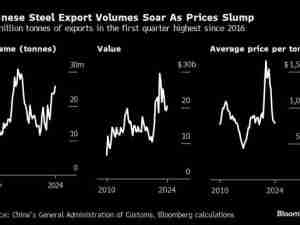U.S. Economy Probably Picked Up in Second Quarter on Spending
By: Shobhana Chandra | Jul 28 2016 at 12:16 PM | International Trade
The U.S. economy’s mid-year report card will probably include hints of progress and room for improvement.
Gross domestic product climbed at a 2.5 percent annualized rate in the second quarter after an uninspiring 1.1 percent pace in the first three months of the year, according to the Bloomberg survey median ahead of Friday’s report.
Households led the charge last quarter, with spending growth projected to match the hardiest advance in more than a decade. Where consumers were resilient, companies were cautious—cutting back on capital investment and aggressively reducing stockpiles. A wrinkle will be introduced as well with the Commerce Department’s annual revisions that include the first quarter.
“We’re looking at a picture of ongoing improvement, with housing and consumption being the strong spots and business investment being a weak spot,” said Thomas Costerg, a senior U.S. economist at Standard Chartered Bank in New York. A pace close to 2 percent “is reasonable growth, nothing exciting but there’s no panic either.”
Here’s what else to watch for in the GDP report at 8:30 a.m. in Washington:
Consumer Spending
Personal spending, which accounts for almost 70 percent of the economy, is projected to have climbed 4.3 percent, matching the increase in October-December 2014 as the biggest since the first quarter of 2006.
An improving job market, a nascent pickup in wages, low inflation, easier credit and cheap borrowing costs represent a favorable backdrop for consumption beyond big-ticket purchases such as autos and homes. Data at the end of the quarter were encouraging: Retail sales rose in June, with 11 of 13 major categories showing higher demand.
The momentum may continue into the third quarter, according to Chris Christopher, an economist at IHS Global Insight, who projects the back-to-school retail season will be stronger this year than last.
Inventories, Trade
Economists were fine-tuning their second-quarter GDP estimates on Thursday after preliminary data showed the trade gap for goods widened 3.6 percent to a four-month high and inventories were held in check.
Wholesale stockpiles were little changed last month after rising 0.1 percent in May, the Census Bureau reported. The June reading was less than the 0.2 percent gain projected in the Bloomberg survey of economists ahead of final figures to be issued Aug. 9. JPMorgan Chase economist Daniel Silver said the slower pace of inventory accumulation will probably reduce second-quarter growth by at least a percentage point.
Stripping out these pieces of the GDP calculation gives economists a better sense of domestic demand. The jump in consumer spending indicates so-called final sales to domestic purchasers, or GDP excluding trade and inventories, probably accelerated after climbing at an inflation-adjusted 1.2 percent rate in the first quarter.
While less inventory building likely weighed on growth, the faster companies get stockpiles aligned with sales, the quicker factory production can recover. That could begin in the second half of the year just as steadier oil prices bring relief to the energy sector and the downward pressure from the dollar’s 2015 surge diminishes.
Business Investment
Corporate spending on equipment likely remained sluggish last quarter, after plunging at an 8.7 percent rate in the prior period, though the monthly durable-goods orders data signaled the weakness wasn’t as pronounced. Shipments of non-defense capital goods excluding airplanes fell at a 1.7 percent pace in the three months through June, compared with an 11.6 percent decline in the three months ended March.
Annual Revisions
Also on Friday, the Commerce Department will release annual revisions to GDP going back to 2013. The updates will likely include modestly higher construction spending and lower business fixed investment, economists at Goldman Sachs wrote in a July 21 note, adding the overall change is likely to be “relatively minor.”

